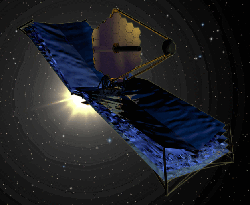NASA announced a few days ago that it has chosen TRW from Redondo Beach, California to build the next generation and replacement for the Hubble Space Telescope. The new telescope will be named after James Webb, who was one of the founders of NASA and its second director.
Avi Blizovsky

NASA announced a few days ago that it has chosen TRW from Redondo Beach, California to build the next generation and replacement for the Hubble Space Telescope. The new telescope will be named after James Webb, who was one of the founders of NASA and its second director.
Webb led the Apollo project that landed the first humans on the moon. He also began the massive space science project, and was responsible for over 75 launches during his tenure, including the first launches of unmanned spacecraft to other planets.
"Thanks to the Web, we got our first look at the landscape of outer space," says current NASA Administrator Sean O'Keefe. "He took the nation on the first voyages of discovery, turning our imagination into reality. He created the era at NASA where amazing astronomical discoveries took place. Thanks to the Hubble Space Telescope that he initiated, and the Chandra X-ray telescope, we can today change the textbooks."
The Webb Telescope will be launched in 2010 using a disposable rocket and not from a space shuttle. It will take three months to reach its goal - an orbit at a distance of 1.5 million kilometers - where there is a balance between the gravitational forces - a point known as the second Lagrange point or L2. At this point the spacecraft will be in balance between the gravitational forces of the Sun and the Earth.
Unlike the Hubble, which hovers only a few hundred kilometers above Earth, astronauts will not be able to reach the Webb telescope for maintenance.
At this point, a sunshield would only be needed on one side of the telescope, then it would be protected from light coming from the Sun or Earth. As a result, it will be able to cool to very low temperatures without the use of complicated cooling equipment. Low temperatures are a necessary condition to prevent the telescope's own energy from dimming the brightness of distant and cold astronomical objects.
Before and during the launch, the mirrors will be folded. After the telescope is placed in orbit, ground controllers will send a message asking the telescope to deploy its high-tech mirror arrays.
To observe the depths of space, the telescope is designed to be sensitive to infrared radiation. The space telescope will also carry a camera in the near-infrared to visible light, as well as a multi-object spectrometer and a mid-infrared camera.
The Webb Telescope will be able to look deeper into the universe than Hubble due to the greater light-gathering ability of the larger mirrors and the instruments' extraordinary sensitivity to infrared light. The diameter of the telescope's main mirror will be 20 feet (six meters approximately) and it will provide much more light than that collected by the Hubble mirror which is only 8 feet (2.4 meters) in diameter.
Infrared viewing capabilities are essential to allow astronomers to understand how the first galaxies formed out of the darkness that came immediately after the rapid expansion and cooling of the universe - a few hundred million years after the Big Bang. The light from these galaxies is currently in the infrared range. Closer to home, the new space telescope will observe planetary disks orbiting young stars as well as study supermassive black holes in other galaxies.
According to the contract with TRW, the cost of the project will be approximately 825 million dollars. TRW will design and manufacture the main mirror and spacecraft. TRW will also be responsible for the integration of the scientific instruments into the spacecraft, as well as performing the pre-flight experiments and tests of the spacecraft in orbit.
NASA's Goddard Flight Center in Greenbelt, Maryland will operate the Webb Telescope for the Office of Space Sciences at NASA Headquarters in Washington. The program includes several industry, and academic and government partners as well as the participation of the European and Canadian space agencies.
More information on the James Webb Space Telescope is available
on the Internet at:
http://www.ngst.nasa.gov
